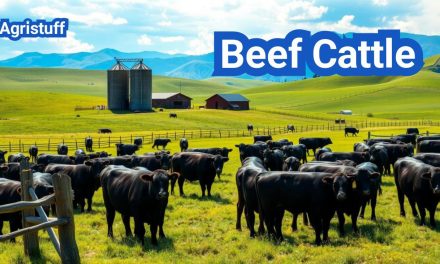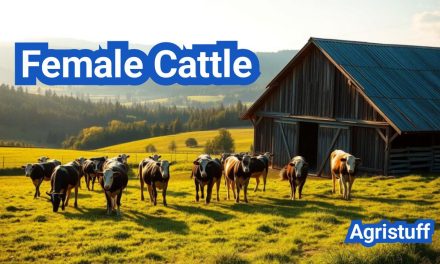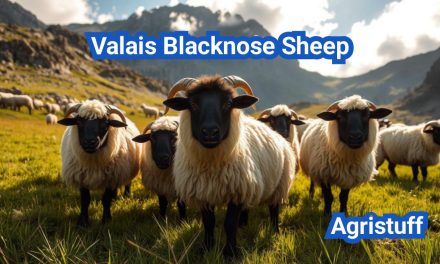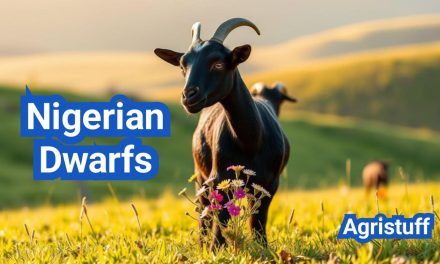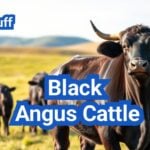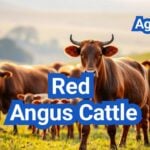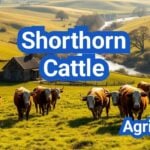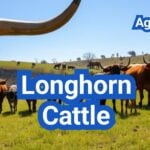The Black Angus cattle breed has a rich history that dates back to Scotland, where it was bred for its high-quality beef. Known for its marbled meat, this breed has become a staple in the cattle industry.
Originating in Scotland, the breed was developed to thrive in harsh climates, producing premium beef. Today, Black Angus cattle are prized worldwide for their unique characteristics and are used in various breeding programs.
This article will delve into the history, origin, characteristics, breeding practices, and uses of Black Angus cattle, providing a comprehensive overview of this significant breed.
Key Takeaways
- Black Angus cattle originated in Scotland.
- The breed is known for its high-quality, marbled beef.
- Black Angus cattle are used in various breeding programs.
- The breed is prized for its unique characteristics.
- Black Angus cattle are significant in the global cattle industry.
The Origins and History of Black Angus Cattle
The story of Black Angus cattle begins in the northeastern counties of Scotland, specifically in Aberdeen and Angus, where the breed originated. Known for their high-quality beef, Black Angus cattle have a rich historical background that spans centuries.
Scottish Beginnings: The Aberdeen Angus
The Aberdeen Angus breed was developed in the 16th century by crossing the local humless cattle of Aberdeen and Angus. The result was a hardy, black, polled breed that was well-suited to the Scottish climate. As noted by cattle historian Robert Trow-Smith, “Aberdeen-Angus cattle were bred to thrive in the rigorous conditions of northeastern Scotland.” The breed quickly gained popularity for its ability to produce high-quality beef.
Journey to North America and Rise to Prominence
Black Angus cattle were first introduced to North America in the late 19th century. The breed was officially recognized in the United States in 1883 with the establishment of the American Angus Association. The association played a crucial role in promoting the breed and maintaining its purity. As stated by the American Angus Association ( Angus Cattle ) , “The Angus breed has become the most popular beef breed in the United States, known for its marbling ability and carcass quality.” The breed’s popularity grew rapidly due to its superior beef quality and adaptability to various farming conditions.
Today, Black Angus cattle are a cornerstone of the beef industry in North America, prized for their genetic superiority and the high-quality beef they produce.
Black Angus Cattle: Breed Overview and Importance

Black Angus cattle have become a cornerstone in the American beef industry due to their exceptional breed characteristics. Their popularity stems from their ability to produce high-quality beef, which is tender and flavorful due to its marbling characteristics.
Key Defining Features of the Breed
The Black Angus breed is distinguished by several key characteristics that contribute to its success in the beef industry. Genetic predisposition to marbling is one of the most significant factors, as it enhances the tenderness and flavor of the beef. Additionally, Black Angus cattle are known for their hardiness and adaptability to various farming conditions.
Other defining features include their black coat color, although they can sometimes be red due to a genetic variation, and their polled trait, meaning they lack horns. This polled characteristic reduces the risk of injury to both the cattle and handlers, making them a safer choice for farming operations.
Economic Impact and Popularity in American Agriculture
The economic impact of Black Angus cattle in American agriculture is substantial. They are one of the most popular breeds used in beef production due to their superior carcass traits and the premium prices their beef commands in the market.
| Economic Factor | Impact | Significance |
|---|---|---|
| Beef Quality | High marbling score | Premium pricing |
| Market Demand | Strong consumer preference | Increased market share |
| Production Efficiency | Hardy and adaptable | Lower production costs |
The breed’s popularity is also driven by the comprehensive breed association programs that support farmers, including registration, genetic evaluation, and marketing services. These programs help farmers to improve their herds and access lucrative markets, further enhancing the economic viability of raising Black Angus cattle.
Physical Characteristics and Identification
Black Angus cattle are renowned for their distinctive physical attributes that contribute to their popularity in the beef industry. Their unique characteristics make them easily identifiable and highly sought after for beef production.
Size, Weight, and Body Conformation
Black Angus cattle are known for their compact, muscular build. Males typically weigh between 1,800 and 2,400 pounds, while females usually range from 1,000 to 1,400 pounds. Their body conformation is characterized by a deep, well-sprung ribcage and a muscular hindquarter, contributing to their overall beef production potential. The breed’s compact size and muscular build make them efficient for beef production.
Key physical attributes include:
- A broad, deep chest
- A well-sprung ribcage
- A muscular hindquarter
- A compact, muscular build
Coat Characteristics and Color Patterns
One of the most distinctive features of Black Angus cattle is their black coat color. The breed’s solid black coat is a result of selective breeding, and it’s a key factor in their identification. While the primary color is black, some individuals may exhibit a slight brown or red tint in their coat, particularly during certain times of the year or due to environmental factors.
Polled Genetics and Physical Traits
Black Angus cattle are also known for their polled (hornless) trait, which is a result of genetic selection. The polled characteristic is dominant, making it a consistent feature across the breed. This trait not only reduces the risk of injury to both the animals and handlers but also simplifies handling and management practices. The polled genetics of Black Angus cattle are a significant factor in their appeal to farmers and breeders.
The combination of their black coat and polled trait makes Black Angus cattle easily recognizable and highly valued in the agricultural industry.
Temperament and Behavioral Traits

Black Angus cattle are renowned for their calm demeanor and robust maternal instincts. This breed is known for its docile nature, making them a preferred choice among cattle farmers. Their temperament and behavioral traits play a significant role in their popularity and ease of handling.
Natural Disposition and Handling Techniques
The natural disposition of Black Angus cattle is generally calm and gentle. This makes them easy to handle, even for less experienced handlers. Effective handling techniques include moving slowly and calmly around the cattle, avoiding sudden noises or movements. Proper handling not only reduces stress on the animals but also improves their overall well-being and productivity.
- Move slowly and calmly around the cattle
- Avoid sudden noises or movements
- Use gentle, consistent handling techniques
Maternal Instincts and Herd Dynamics
Black Angus cows are known for their strong maternal instincts. They are protective of their calves and often form close bonds within the herd. Understanding herd dynamics is crucial for effective cattle management. By recognizing the social structure within the herd, farmers can better manage the cattle’s behavior and reduce stress.
Key aspects of herd dynamics include:
- Social hierarchy within the herd
- Interactions between cows and their calves
- Overall herd behavior and cohesion
How to Select Quality Black Angus Cattle
Quality selection is the foundation of a successful Black Angus cattle breeding program. Selecting the right animals involves a thorough assessment of their conformation, performance data, and adherence to breed standards.
Evaluating Conformation and Structure
Evaluating the conformation and structure of Black Angus cattle is crucial for identifying animals with the potential to excel in breeding or production. This process involves both visual assessment techniques and the interpretation of performance data.
Visual Assessment Techniques
Visual assessment involves examining the animal’s physical characteristics, such as:
- Muscling and body depth
- Structural correctness of legs and feet
- Overall balance and symmetry
Performance Data Interpretation
Performance data provides valuable insights into an animal’s genetic potential and growth traits. Key data points include:
- Birth weight and weaning weight
- Average daily gain
- Yearling weight
Breed Standards and Registration Requirements
Understanding and adhering to Black Angus breed standards is essential for maintaining the integrity and quality of the breed. Registration with a reputable breed association, such as the American Angus Association, is a critical step in verifying an animal’s pedigree and breed characteristics.
Key registration requirements include:
- Pedigree verification
- DNA testing for parentage verification
- Adherence to breed standards for physical characteristics
By carefully evaluating conformation, interpreting performance data, and ensuring compliance with breed standards and registration requirements, breeders can select high-quality Black Angus cattle that will enhance their breeding program.
Breeding Black Angus Cattle: Step-by-Step Process

Successful breeding of Black Angus cattle hinges on selecting the right breeding stock and managing the breeding season effectively. Breeding these cattle is a complex process that requires careful planning, a thorough understanding of genetics, and meticulous management during the breeding season and calving.
Selecting Superior Breeding Stock
The foundation of a successful Black Angus breeding program is the selection of superior breeding stock. This involves evaluating both bulls and heifers/cows based on specific criteria to ensure the production of high-quality offspring.
Bull Selection Criteria
When selecting a bull, several factors are considered, including genetic traits, fertility, and physical conformation. A bull’s genetic makeup should enhance the quality of the herd, and its fertility is crucial for successful breeding.
Heifer and Cow Evaluation
Heifers and cows are evaluated based on their reproductive history, genetic background, and physical condition. The goal is to identify females that will produce high-quality calves and contribute to the overall health and productivity of the herd.
| Evaluation Criteria | Bull | Heifer/Cow |
|---|---|---|
| Genetic Traits | High-quality genetics for growth and marbling | Genetic background for fertility and milk production |
| Fertility | High fertility rates | Reproductive history and current fertility status |
| Physical Conformation | Structural correctness and muscling | Body condition score and overall health |
Breeding Season Management
Effective breeding season management is critical for the success of a Black Angus breeding program. This includes planning the breeding season to coincide with optimal calving times and ensuring that the breeding stock is healthy and ready for breeding.
“The key to a successful breeding season is preparation. Ensuring that your breeding stock is in top condition and that you have a well-planned breeding program can significantly impact the quality and quantity of your calf crop.”
Calving Procedures and Newborn Care
Calving is a critical period in the breeding cycle, requiring careful monitoring and assistance when necessary. Proper newborn care is also essential for the health and survival of the calves.
Preparing for Calving
Preparation for calving involves ensuring that facilities are clean and ready for the cows about to give birth. It also includes having a plan in place for assisting with difficult births.
Assisting Difficult Births
Knowing when and how to assist with difficult births is crucial. This may involve having a veterinarian on standby or having trained staff capable of providing the necessary assistance.
Post-Birth Management
After birth, ensuring that the cow and calf are healthy is paramount. This includes monitoring the cow’s health and ensuring that the calf is nursing properly.
By following these steps and ensuring that breeding stock is superior, the breeding season is well-managed, and calving procedures are properly handled, farmers can achieve a successful breeding program for their Black Angus cattle.
Nutritional Management for Optimal Growth
Adequate nutrition is crucial for the development and productivity of Black Angus cattle. Proper nutritional management involves a combination of pasture development, appropriate feed rations, and effective water management systems.
Pasture Development and Rotational Grazing
Pasture development is a critical component of nutritional management for Black Angus cattle. Implementing rotational grazing practices helps maintain pasture health and productivity. This involves dividing pastures into smaller sections and rotating cattle through them to avoid overgrazing.
Benefits of Rotational Grazing:
- Increased forage utilization
- Improved soil health
- Enhanced biodiversity
Feed Rations and Supplementation Guidelines
Feed rations for Black Angus cattle should be formulated based on their nutritional needs at different stages of their lifecycle.
Calf Nutrition
Calves require high-quality nutrition for optimal growth and development. This includes adequate colostrum intake at birth followed by a nutrient-rich diet.
Mature Cattle Requirements
Mature cattle have different nutritional needs compared to calves. Their diet should be balanced to maintain optimal body condition and productivity.
Finishing Diets
Finishing diets are crucial for cattle being raised for beef production. These diets are formulated to enhance marbling and overall meat quality.
| Nutritional Stage | Dietary Requirements | Feeding Objectives |
|---|---|---|
| Calf | High protein, adequate energy | Support growth and development |
| Mature | Balanced energy and protein | Maintain body condition |
| Finishing | High energy, precise protein levels | Enhance marbling and meat quality |
Water Management Systems
Access to clean, fresh water is essential for the health and productivity of Black Angus cattle. Effective water management systems ensure that cattle have adequate water intake.
“Water is the most critical nutrient for cattle, and its availability can significantly impact their productivity and health.”
Health Care Protocols for Black Angus Cattle

Implementing preventative health measures is vital for the well-being of Black Angus cattle. A comprehensive health care program is essential to prevent diseases and ensure the overall productivity of the herd.
Preventative Health Program Implementation
A preventative health program for Black Angus cattle should include regular veterinary check-ups, monitoring of herd health, and implementation of biosecurity measures. This proactive approach helps in early detection and management of potential health issues.
Vaccination Schedule and Administration Techniques
Vaccinations play a crucial role in protecting Black Angus cattle from infectious diseases. A well-planned vaccination schedule, administered by a qualified veterinarian, is vital. The schedule should be tailored to the specific needs of the herd, considering factors like age, health status, and environmental risks.
Parasite Control and Treatment Methods
Effective parasite control is critical for maintaining the health of Black Angus cattle. This involves managing both internal and external parasites.
Internal Parasites
Internal parasites, such as worms, can significantly impact the health and productivity of Black Angus cattle. Regular deworming and monitoring of parasite loads are essential components of a parasite control program.
External Parasites
External parasites, including ticks, flies, and lice, can cause discomfort and transmit diseases. Control measures include the use of insecticides and implementing management practices that reduce parasite exposure.
| Parasite Type | Control Measures | Benefits |
|---|---|---|
| Internal Parasites | Regular deworming, monitoring | Improved health, productivity |
| External Parasites | Insecticides, management practices | Reduced disease transmission, improved comfort |
By implementing these health care protocols, Black Angus cattle producers can significantly enhance the health and productivity of their herds, leading to better overall performance and profitability.
Creating Proper Housing and Handling Facilities

The welfare of Black Angus cattle depends significantly on the quality of their housing and handling facilities. Properly designed housing not only enhances the animals’ comfort but also improves farm efficiency and productivity.
Shelter Design and Space Requirements
Adequate shelter is crucial for protecting Black Angus cattle from extreme weather conditions. The design should consider the local climate, with features such as:
- Ventilation systems to maintain air quality
- Roofing materials that provide insulation
- Space allocations that prevent overcrowding
According to agricultural experts, a well-designed shelter can reduce stress among cattle, leading to better overall health. As noted by agricultural specialist, Temple Grandin, “Cattle that are comfortable and stress-free are more likely to be healthy and productive.”
“Cattle that are comfortable and stress-free are more likely to be healthy and productive.” – Temple Grandin
Fencing Systems and Handling Equipment
Robust fencing is essential for containing Black Angus cattle and ensuring their safety. The choice of fencing material and design should be based on durability and the ability to withstand various weather conditions.
| Fencing Type | Durability | Cost |
|---|---|---|
| Wooden Fencing | High | Moderate |
| Metal Fencing | Very High | High |
| Electric Fencing | Moderate | Low |
Seasonal Management Adaptations
Effective seasonal management is critical for maintaining the health and productivity of Black Angus cattle. This involves preparing for both winter and summer conditions.
Winter Preparations
Winter preparations include ensuring adequate shelter, providing extra nutrition to maintain body heat, and monitoring weather forecasts to prepare for extreme cold snaps.
Summer Heat Mitigation
During summer, it’s essential to provide shade, ensure adequate ventilation, and supply plenty of fresh water to mitigate heat stress.
By focusing on these aspects, farmers can create a more sustainable and productive environment for their Black Angus cattle, ultimately enhancing their welfare and the overall efficiency of the farm.
Commercial Applications of Black Angus Cattle

The commercial applications of Black Angus cattle are diverse, ranging from beef production to seedstock breeding. Black Angus cattle are highly valued for their quality beef and are used in various commercial contexts.
Beef Production Systems and Quality Grades
Black Angus cattle are renowned for their marbling ability, which significantly enhances the quality of beef. The breed is often used in crossbreeding programs to improve the marbling characteristics of other breeds.
Grass-Finished vs. Grain-Finished
The production system for Black Angus beef can vary, with some producers opting for grass-finished beef and others for grain-finished. Grass-finished beef is produced by raising cattle on pasture until slaughter, while grain-finished beef involves feeding cattle a diet of grains during the finishing phase to enhance marbling.
Carcass Merit and Evaluation
Carcass evaluation is critical in determining the quality grade of beef. Factors such as marbling, maturity, and muscling are assessed to assign a quality grade. Black Angus cattle typically yield high-quality grades due to their inherent marbling ability.
Seedstock Production and Genetic Improvement
In addition to beef production, Black Angus cattle are also used in seedstock production. Seedstock producers focus on breeding high-quality animals that can be used to improve the genetics of other herds. The selection of superior breeding stock is crucial in this process.
By leveraging the genetic potential of Black Angus cattle, producers can enhance the efficiency and profitability of their operations. Whether for beef production or seedstock breeding, Black Angus cattle offer a range of commercial opportunities.
How to Establish Your Own Black Angus Herd

Creating a thriving Black Angus herd involves a multifaceted approach that includes business planning, land assessment, and marketing. To successfully establish your operation, you must consider several critical factors that will impact the long-term viability and profitability of your venture.
Business Planning and Initial Investment Analysis
A comprehensive business plan is essential for any new agricultural enterprise, including a Black Angus cattle operation. This plan should outline your goals, production costs, marketing strategies, and financial projections. Initial investment analysis is crucial, as it will help you understand the costs associated with purchasing high-quality breeding stock, developing pastureland, and constructing necessary infrastructure.
The initial investment for a Black Angus herd can be substantial. The costs include purchasing cattle, land preparation, fencing, and initial veterinary care. A detailed financial plan will help you secure funding and manage your resources effectively.
| Initial Investment Category | Estimated Cost |
|---|---|
| Purchasing Breeding Stock | $10,000 – $50,000 |
| Land Preparation and Fencing | $5,000 – $20,000 |
| Initial Veterinary Care | $1,000 – $3,000 |
| Total Estimated Initial Investment | $16,000 – $73,000 |
Land Assessment and Stocking Rate Calculation
Land assessment is a critical step in establishing a Black Angus herd. You need to evaluate the quality and quantity of your pastureland to determine its carrying capacity. This involves assessing the forage production, soil quality, and existing infrastructure.
Stocking rate calculation is directly related to land assessment. It involves determining the number of cattle your land can support without degrading the pasture. A well-managed stocking rate ensures the sustainability of your operation and the health of your cattle.
Marketing Strategies for Black Angus Products
Developing effective marketing strategies is vital for the success of your Black Angus operation. You need to identify your target market, whether it’s beef consumers, other breeders, or restaurants, and tailor your marketing efforts accordingly. Highlighting the unique qualities of Black Angus beef, such as its marbling and tenderness, can help differentiate your product in a competitive market.
Utilizing digital marketing, attending agricultural events, and engaging in local farmers’ markets are effective ways to promote your products and build a customer base.
Sustainable Practices in Black Angus Cattle Raising

The Black Angus cattle industry is shifting towards more sustainable practices, driven by the need to balance economic viability with environmental stewardship. Sustainable practices in Black Angus cattle raising involve a range of techniques and strategies aimed at reducing the environmental footprint of cattle farming while maintaining its productivity.
Environmental Stewardship Techniques
Environmental stewardship is critical in Black Angus cattle raising, involving practices that protect natural resources. Techniques include rotational grazing, which helps maintain soil health and reduce erosion, and the use of cover crops to enhance biodiversity. As noted by the National Cattlemen’s Beef Association, “Sustainable cattle production is not just about the environment; it’s also about being good neighbors and responsible stewards of our natural resources.”
“Sustainable cattle production is not just about the environment; it’s also about being good neighbors and responsible stewards of our natural resources.”
National Cattlemen’s Beef Association
Rotational grazing is particularly effective, allowing pastures to recover and rebuild, which in turn supports healthier cattle. This method also helps in sequestering carbon, thus contributing to a reduction in the carbon footprint of cattle farming.
Resource Conservation and Management
Resource conservation is another vital aspect of sustainable Black Angus cattle raising. This involves efficient water management systems and the use of technology to monitor and manage cattle health and nutrition. Effective resource management not only reduces waste but also enhances the overall productivity of the farm.
| Resource | Conservation Method | Benefit |
|---|---|---|
| Water | Efficient irrigation systems | Reduced water waste |
| Pasture | Rotational grazing | Improved soil health |
| Energy | Renewable energy sources | Lower carbon footprint |
By adopting these sustainable practices, Black Angus cattle farmers can ensure the long-term viability of their operations while contributing to a more environmentally friendly agricultural sector.
At The End of: Black Angus Cattle
The Black Angus cattle breed has been extensively discussed throughout this article, highlighting its rich history, distinct characteristics, and significant role in the agricultural industry. Originating in Scotland, the breed has evolved over time to become a prominent force in global beef production.
A key takeaway is the importance of proper breeding, nutritional management, and health care protocols in maintaining a thriving Black Angus herd. By understanding the breed’s temperament, behavioral traits, and physical characteristics, farmers can make informed decisions to optimize their operations.
In conclusion, the Black Angus cattle breed offers numerous benefits for farmers and consumers alike. As the agricultural industry continues to evolve, the demand for high-quality beef is expected to drive the growth of Black Angus cattle production. By summarizing the key aspects of this breed, we can better appreciate its value and potential in the global market.
FAQ
What is the origin of Black Angus cattle?
Black Angus cattle originated in Scotland, specifically in the Aberdeen region, where they were bred for their high-quality beef.
What are the key characteristics of Black Angus cattle?
Black Angus cattle are known for their black coat color, polled trait, and high-quality beef. They are also recognized for their muscular build and robust body conformation.
How do I select quality Black Angus cattle?
To select quality Black Angus cattle, evaluate their conformation, structure, and performance data. It’s also essential to understand breed standards and registration requirements.
What are the nutritional needs of Black Angus cattle?
Black Angus cattle require a balanced diet that includes high-quality pasture, feed rations, and access to clean water. Nutritional needs vary at different stages of their life, such as during breeding, calving, and growth.
How do I manage the health of my Black Angus cattle?
Implementing preventative health measures, following a vaccination schedule, and controlling parasites are crucial for maintaining the health and productivity of Black Angus cattle.
What are the benefits of raising Black Angus cattle sustainably?
Raising Black Angus cattle sustainably involves environmental stewardship techniques and resource conservation methods, which can improve the overall health of the cattle and the land.
How do I establish a successful Black Angus cattle operation?
To establish a successful Black Angus cattle operation, develop a business plan, assess your land, calculate stocking rates, and create marketing strategies for your products.
What are the commercial applications of Black Angus cattle?
Black Angus cattle are used in beef production systems, and their genetics are also used to improve the quality of other cattle breeds through seedstock production.
How do I breed Black Angus cattle effectively?
Breeding Black Angus cattle involves selecting superior breeding stock, managing the breeding season, and providing proper care during and after calving.
What are the advantages of Black Angus cattle in terms of temperament and behavior?
Black Angus cattle are known for their docile temperament and strong maternal instincts, making them easier to handle and manage.
Conclusion of: Black Angus Cattle
Black Angus Cattle are among the most recognized beef breeds in the United States, valued for predictable marbling, maternal efficiency, calm temperament, and strong market demand across premium beef programs; in this guide, we cover the full story of Black Angus Cattle—from Scottish roots to modern U.S. breeding, selection, and marketing strategies—so you can make informed herd decisions that fit American conditions and buyers. American Angus Association
History & Scottish Origin of Black Angus Cattle
Black Angus Cattle originated in northeast Scotland from naturally polled, predominantly black cattle refined in the 19th century, when improvers like Hugh Watson and William McCombie fixed a uniform, productive beef type that later became the global foundation for the breed; this historical context explains why Black Angus Cattle combine hardiness, thriftiness, and beef quality. Encyclopaedia Britannica — Aberdeen-Angus
Journey to America and Early Adoption
Black Angus Cattle arrived in the United States in the late 1800s and quickly impressed ranchers for calving ease, carcass merit, and adaptability; those advantages accelerated formation of a U.S. registry and widespread use of Black Angus Cattle in both purebred and crossbred programs across the Plains and Midwest. American Angus Association
Why Black Angus Cattle Dominated U.S. Beef
Black Angus Cattle became a U.S. phenomenon because their intrinsic traits aligned with commercial goals: low-input maternal cows, feedyard performance, and consistent marbling that wins premiums; over time, brand programs reinforced consumer trust in beef from Black Angus Cattle, further elevating demand. Certified Angus Beef® (Official)
Core Breed Characteristics
Black Angus Cattle are naturally polled, medium-framed beef animals known for docility, fertility, efficient feed conversion, and sound structure; the breed’s balance of maternal and carcass traits helps U.S. cow-calf operators reduce labor and improve weaning weights while positioning calves from Black Angus Cattle for premium grids. University of Nebraska–Lincoln Beef Extension
Meat Quality and Marbling Advantages
Premium eating quality is central to the appeal of Black Angus Cattle, whose genetics typically produce elevated intramuscular fat (marbling) that supports USDA Prime and Choice grades; this marbling translates to tenderness, juiciness, and flavor that consumers consistently reward in the marketplace for beef from Black Angus Cattle. USDA AMS — Beef Grades & Standards
Color Genetics: Why Black Prevails
Coat color in Black Angus Cattle is largely controlled by the Extension (MC1R) locus where black alleles are dominant to red, so black typically masks red in crossbred calves; understanding basic color genetics helps producers plan phenotypes and marketing targets when using Black Angus Cattle as sires or dams in commercial systems. UC Davis Veterinary Genetics Laboratory
Black vs. Red Angus Registries in the U.S.
Although derived from the same Scottish foundation, U.S. registries diverged by color, with Black Angus Cattle registering under the American Angus Association and red cattle under the Red Angus Association; both color lines emphasize functional beef traits, but brand and market programs often highlight black-hided cattle from Black Angus Cattle. Red Angus Association of America
Certified Programs and What They Mean
Not all “Angus” labels are equal; audited brand programs impose specifications beyond simple Angus influence, and producers targeting premiums with Black Angus Cattle should learn verification requirements, carcass thresholds, and auditing processes before committing to a grid or brand. USDA AMS — Auditing & Verification
Certified Angus Beef® (CAB®) in Practice
Certified Angus Beef® is a leading brand with documented standards around marbling, maturity, and carcass specifications, and calves with substantial Angus influence—especially from Black Angus Cattle selected for marbling—are prime candidates for meeting CAB® thresholds when properly managed through finishing. CAB® — Brand & Specifications
USDA Grading and Premium Signals
USDA quality grades (Prime, Choice, Select) are the common language of value in many grids, and Black Angus Cattle are widely used to aim for upper Choice or Prime because of marbling propensity; aligning genetics, days on feed, and slaughter endpoints gives Black Angus Cattle a clear path to premiums. USDA AMS — Beef Grades & Standards
EPDs: The Selection Engine for Progress
Expected Progeny Differences (EPDs) are the core tools for comparing genetic merit within breed, allowing you to rank Black Angus Cattle for traits like Calving Ease Direct (CED), Birth Weight (BW), Weaning Weight (WW), Yearling Weight (YW), Marbling (MARB), and more; using EPDs prevents guesswork and accelerates reliable gains in Black Angus Cattle herds. American Angus Association
Indexes and Balanced Breeding
Economic selection indexes unify multiple traits into a single value to help avoid single-trait selection; for Black Angus Cattle, indexes oriented to maternal herds or terminal endpoints guide choices that keep calving ease, growth, fertility, feet/legs, and carcass merit in balance across your Black Angus Cattle program. University of Minnesota Extension — Beef
Genomics: Accuracy Sooner
Genomic-enhanced EPDs add DNA information to traditional evaluation, boosting accuracy in young animals and helping identify superior replacements and AI sires among Black Angus Cattle; genomics is especially powerful when your herd is growing fast and you need confident decisions early on Black Angus Cattle. CAB® — Research & Education
Maternal Strength, Udder Quality & Docility
Beyond carcass merit, Black Angus Cattle are respected for mothering ability, udder quality, calf vigor, and docility, all of which reduce labor and safety risks during calving and handling; selecting for disposition and structural soundness sustains longevity and profitability in Black Angus Cattle cows. University of Nebraska–Lincoln Beef Extension
Heifer Projects and Calving Ease
Heifer breeding programs with Black Angus Cattle typically emphasize CED and low BW EPDs to reduce dystocia while retaining growth and marbling potential; combining appropriate genetics with body-condition management and mineral programs keeps heifers on track for first-calf success among Black Angus Cattle. University of Minnesota Extension — Beef
Crossbreeding: Black Baldies & Heterosis
Angus × Hereford “Black Baldies” remain a proven cross for commercial systems, leveraging heterosis for fertility, longevity, and cow efficiency while adding carcass value from Black Angus Cattle; planned terminal sires can then push gain and cutability to meet grid targets effectively. University of Missouri Extension — Crossbreeding Systems (G2040)
Nutrition & Forage Matching
Meeting protein, energy, and mineral needs by production stage is fundamental to reproductive success and weaning weights in Black Angus Cattle; matching calving seasons and supplementation to regional forage curves stabilizes condition scores and improves lifetime productivity of Black Angus Cattle cows. North Dakota State University Extension
Health, Biosecurity & Low-Stress Handling
Preventive herd health programs, resident-friendly biosecurity, and low-stress stockmanship reduce pulls and treatment costs while safeguarding gains in Black Angus Cattle; simple protocols around vaccinations, parasite control, and preconditioning underpin performance from pasture to feedyard for Black Angus Cattle calves. USDA — Animals & Livestock
Marketing Black Angus Cattle for Premiums
To access premiums, align genetics and management with the specs of your intended program, document age/source where required, and hit the carcass windows that grids reward; with clear targets, Black Angus Cattle can consistently qualify for branded programs and negotiated grid advantages in the U.S. market. USDA AMS — Auditing & Verification
Seedstock vs. Commercial Goals
Seedstock breeders of Black Angus Cattle may emphasize accuracy, genomic testing, and comprehensive data submission, while commercial producers often prioritize fertility, structural soundness, and saleable calves; setting a written breeding objective avoids drift and maintains focus in a Black Angus Cattle program. American Angus Association
Structural Soundness & Feet/Legs
Feet and leg conformation, hoof integrity, and udder suspension are economic traits because they influence mobility, grazing time, and longevity; culling problem cows and selecting sound sires protects lifetime productivity and welfare in Black Angus Cattle herds. University of Nebraska–Lincoln Beef Extension
Data Discipline: Weights, Scores, & Records
Consistent birth, weaning, and yearling weights, along with docility and udder scores, elevate the value of seedstock and sharpen selection in commercial herds of Black Angus Cattle; disciplined record-keeping turns individual observations into measurable progress among Black Angus Cattle. University of Minnesota Extension — Beef
Feedyard Performance & Harvest Endpoints
Days on feed, ration energy density, and endpoint management determine whether calves from Black Angus Cattle capture upper Choice or Prime without excessive yield grade discounts; combining growth and marbling EPDs with sound bunk management is a proven pathway for Black Angus Cattle to excel in finishing. USDA AMS — Beef Grades & Standards
Understanding Labels: “Angus” vs. CAB®
“Angus” often indicates genetic influence or hide color, whereas Certified Angus Beef® is an audited brand with documented carcass specifications; producers using Black Angus Cattle should plan for the exact criteria of their target program rather than assuming generic “Angus” labeling will deliver premiums. CAB® — Brand & Specifications
Where to Start: A Practical Checklist
Define your marketing target, select sires with the right mix of calving ease, growth, and marbling, mind feet/legs and udder quality, and manage nutrition for reproduction and longevity; by following a written plan, you’ll turn Black Angus Cattle genetics into reliable, compounding results. American Angus Association
Final thought
Black Angus Cattle have earned their standing by consistently converting genetics and good management into premium beef and efficient cows; with clear goals, strong record-keeping, and disciplined selection, your operation can harness the full potential of Black Angus Cattle across America’s diverse environments. Certified Angus Beef® (Official)
Sources & References
- Certified Angus Beef® — Official Site
- USDA AMS — Beef Grades & Standards
- USDA AMS — Auditing & Verification Programs
- Encyclopaedia Britannica — Aberdeen-Angus
- University of Missouri Extension — Crossbreeding Systems (G2040)
- University of Nebraska–Lincoln — Beef Extension
- University of Minnesota Extension — Beef
- UC Davis Veterinary Genetics Laboratory
- USDA — Animals & Livestock


